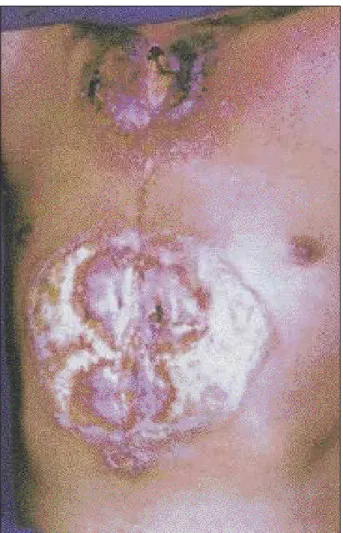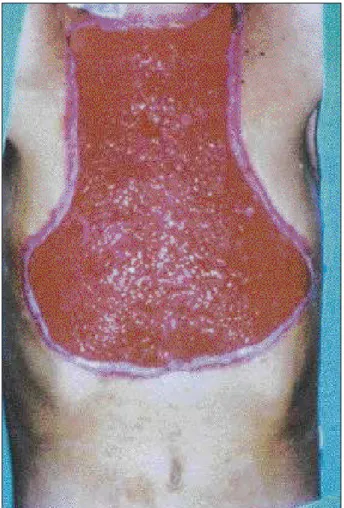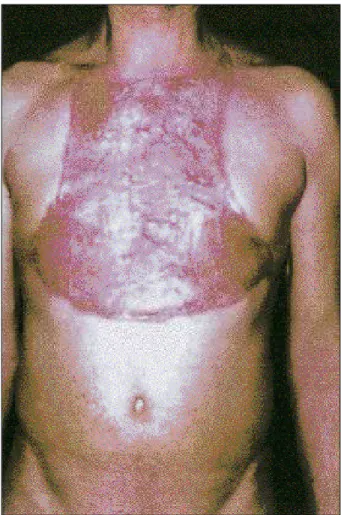Hospital São Francisco da Santa Casa de Porto Alegre
Mailling address: José Dario Frota Filho – Rua Freitas Cabral, 305/602 – 90690-130 – Porto Alegre, RS
José Dario Frota Filho, Carlos Drews, Paulo Leães, Celso Blacher, Francisco Tostes, Nilton Delatorre, Mariana Vieira, Eraldo Lúcio, Wagner Pereira, Marcela Sales, Roberto Lobo, Ralf Stuermer,
Nicasio Tanaka, Luis Portugal, Fernando Lucchese
Porto Alegre, RS - Brazil
Postoperative Necrotizing Fasciitis of the Thorax in
Cardiac Surgery
Necrotizing fasciitis is a rare soft tissue infection and a life-threatening emergency, often fatal. Its incidence and management are described plentifully in the medical lite-rature regarding the most common anatomical sites invol-ved like the abdomen, lower and upper limbs, and perine-um. However, available data and case reports of chest wall necrotizing fasciitis after thoracic procedures are scarce, mainly after major cardiac operations. We report and dis-cuss a case of necrotizing fasciitis of the chest wall occur-ring in the immediate postoperative period of a cardiac procedure, and include a brief review of the concepts, pa-thophysiology, and treatment reported in the medical literature. We emphasize the need for early diagnosis and urgent and effective surgical debridement. Of importance is the fact that we have not found any references in the lite-rature to cases similar or equal to the one we describe he-re, which occurred in the postoperative period of a car-diac procedure.
Necrotizing fasciitis of the chest wall is a rare disease that usually takes place as a complication of surgical proce-dures in the cervical region, spreading downward to the an-terior chest wall, pericardium, and even the deep mediastinal structures 1. Reports in the medical literature are very
plenti-ful regarding necrotizing fasciitis occurring in other topo-graphic body areas but otherwise scarce when focusing pri-marily on the thoracic incidence and management. Althou-gh the general therapeutic strategies used in necrotizing fas-ciitis are also applied to thoracic fasfas-ciitis, some special fea-tures exist that should be emphasized when dealing with thoracic necrotizing infections, beyond the unique posto-perative issues involving either an intra- or extra- cardiac
im-planted prosthesis. The differential diagnosis between ne-crotizing fasciitis and non-nene-crotizing soft tissue infections should be a priority, as they present different prognostic and therapeutic implications 2. In this brief communication,
we focus on a literature review regarding concepts, patho-physiology, and treatment of necrotizing fasciitis and report and discuss a rare case of anterior chest wall necrotizing fas-ciitis as a complication of cardiac surgery. To our knowledge, no such cases have been reported in the medical literature.
Case Report
The patient is a 38-year-old male with Marfan’s Syn-drome, who presented with a huge aneurysm of the ascen-ding aorta (8 cm in diameter), severe aortic valve regurgita-tion, and severe left ventricular dysfunction. His previous medical history included septic shock as a complication in the postoperative period of an orthopedic procedure to the left ankle due to a traumatic fracture. At present, the surgical procedure was an aortoplasty with a composite Dacron and bovine pericardium graft (Labcor Laboratórios Belo Hori-zonte - Brazil), in which a double leaflet mechanical aortic prosthesis was attached Carbomedics Inc., USA, and coro-nary ostia reimplantation was performed. The immediate evolution included persistent fever and inflammatory signs at the upper and lower incision limits, with a yellowish dis-charge. Computerized tomography of the thorax and media-stinum showed a viscid pus-like collection around the aortic graft suggestive of mediastinitis. The sternum was stable. Incision and drainage of 2 incisional abscesses were performed. The infectious process spread through the nei-ghboring tissues with formation of small abscesses, frankly purulent discharge, cellulites, and skin necrosis (Fig. 1). The first wide debridement, with resection of all apparently necrotic tissues, was performed, but soon we realized that it was ineffective(Fig. 2). Septic shock and local crepitus we-re established, and the diagnosis of necrotizing fasciitis of
postoperative day (Fig. 5). The viscid pus-like collection first seen on computerized tomography scan had already completely subsided, and the sternum was still stable. The patient completely recovered and was discharged. Of ut-most importance in the reported case is the fact that none of the cultures from various materials were positive (pus, blood, fragments of tissues, and temporary pacemaker wires).
Discussion
Necrotizing fasciitis was first mentioned by Hippocrates around the 5th century A.D. as a complication of erysipela.
Later on, the first case was reported by Meleney in 1924 3.
Quite different from erysipela, necrotizing fasciitis is an un-common but highly lethal soft tissue infection caused by virulent organisms and their necrotoxins, mainly Group A beta-hemolytic Streptococcus 4. Extensive fascial necrosis,
including also the skin and subcutaneous tissue, systemic toxicity, septic shock, multiorgan failure and death, unless promptly diagnosed and treated, are characteristic of necro-tizing fasciitis. The medical literature widely describes ne-crotizing fasciitis taking place in various anatomical re-gions. However, references about thoracic necrotizing fas-ciitis occurring primarily as a complication of thoracic pro-cedures are scarce. Only 9 cases had been reported on up to the anterior chest wall was made. Broad-spectrum
anti-biotics (an association of vancomycin and cefazolin, and imipenem later on) were started together with fluid resus-citation and general cardiorespiratory supportive care. Aggressive surgical debridements were performed trying to reach normal bleeding-and healthy edges of the soft tissues (Fig. 3). We decided not to redo mediastinal exploration due to the sternal stability and lack of other local signs of medi-astinitis. The necrotic fascia was easily detached from the muscular bed by blunt dissection. The progression of the necrotizing fasciitis kept on, and it was necessary to surgi-cally remove affected areas on a daily basis, under general anesthesia, up to the point were the necrotizing fasciitis was completely controlled. No topical antibiotic or other agents were used as a routine to ease the identification of compro-mised tissues at the time of debridement. On the 14th
postope-rative day, the patient was still presenting systemic signs of sepsis with loss of renal function. From the third week on, the infection was completely controlled, the multiorgan sys-temic response was almost normal, and exuberating granu-lation tissue existed (Fig. 4). Dressings were then applied at bedside with no need of general anesthesia. The plastic and reconstructive team was contacted, and the chest wall scar was repaired with skin flaps from the thighs, on the 51st
Fig. 1 - Soft tissue necrosis of the upper and lower thirds of the wound on the 8th
PO day.
1997, including 4 cases after tube thoracostomy for empye-ma, 3 cases after gastroesophageal surgery (repair of spon-taneous esophageal rupture, repair of gastritis and esopha-gectomy for cancer), 1 case after pneumonectomy, and 1 case after thoracic trauma 5. Probably some more cases exist
that unfortunately have not been reported up to the present. Of great importance is the fact that we have not found any literature reference about chest wall necrotizing fasciitis as a complication of an intracardiac procedure.
Soft tissue necrotizing infections are more likely to oc-cur in immunologically compromised individuals, chiefly in diabetics. Thirty-three percent of all postoperative suppu-rative complications of thoracic surgery, in the main due to deficiencies in the immunologic state of patients, were re-ported in children with inherited syndromes of the connecti-ve tissue. The most serious immunologic disturbances were observed in children with Marfan´s syndrome, due to ina-dequate phagocytosis of the neutrophils and monocytes and a decreased number of T, active T, and B linfocytes 6.
In very rare occasions, only one organism is responsi-ble for the devastating fascial necrosis and systemic toxici-ty seen in necrotizing fasciitis (eg, necrotizing fasciitis cau-sed by Streptococcus pyogenes). In the vast majority of ca-ses, the synergistic action of aerobic and anaerobic orga-nisms is responsible for a polymicrobial infection.
Facultati-ve organisms reduce the oxidation-reduction potential of the wound and promote favorable conditions for the growth of anaerobes. These last, in turn, impair the host phagocyte function and hence facilitate the growth of ae-robes. Several bacteria, such as Bacteroides fragilis, produce beta-lactamase enzyme, which lessens antibiotic action. The number and kind of bacteria is related to the region affected 7,8. The most frequently identified organisms
include aerobic and anaerobic streptococcus, coagulant-positive and coagulant-negative staphylococcus, facul-tative and aerobic Gram-negative rods, bacteroid species and Clostridium 5.
The necrotic alterations are directly related to the in-fectious process, with activation of the coagulation system, resulting in local thrombosis and infarction, with the aid of bacterial heparinase production. Tissue ischemia and ano-xia, together with edema, promote increased pressures wi-thin the soft tissues and further impair the blood supply.
The diagnosis is essentially made on clinical grounds 9
and requires an attitude of high suspicion because the early soft tissue alterations are unspecific. The external appea-rance of the skin wound may have no correlation with the magnitude of the deep fascial necrosis, being a factor that contributes to a diagnostic delay. The characteristic signs
Fig. 3 - Aggressive surgical debridement extending up to the anterior axillary lines,
appear some days after the initial event, at the end of the first week in most cases (Fig. 1). Highly unproportional wo-und pain as compared with the mild local changes, as well as leukocytosis, should alert one to this condition 10.
Gaseo-us infiltration of the soft tissues, detected by imaging me-thods or crepitus, is a classic sign, although its absence does not exclude necrotizing fasciitis 7. Septic shock and
mul-tiorgan failure are common features and require prompt ins-titution of fluid resuscitation and cardiorespiratory care 8,9.
Surgical exploration is the most important therapeutic and diagnostic tool, as it may demonstrate the lack of adherence between the necrotic fascia and its muscle 7, another
patho-logic characteristic of necrotizing fasciitis 9. In our case, the
diagnosis made only on the 8th postoperative day when
crepitus, septic shock, and advanced soft tissue necrosis occurred. This delay is partially explained by the fact that necrotizing fasciitis is a rare infection after cardiac surgery, which in turn lowers our threshold of clinical suspicion.
Chest X-Ray, magnetic resonance imaging, computeri-zed tomography, and ultrasound are additional examina-tions for eliciting the diagnoses 9. Computerized
tomogra-phy and ultrasound, as well as conventional X-ray, may evi-dence the presence of gas in affected tissues, mainly in dia-betics 11,7. Computerized tomography and magnetic
reso-nance imaging are useful for delimitation of the extent and spreading of the necrotizing infection 12. In our reported
ca-se, the suggested diagnosis of mediastinitis from compute-rized tomography scan could potentially have induced a more aggressive exploratory thoracotomy, reopening the sternum and extending the infection into the deep mediasti-nal structures. It is important to bear in mind that anterior and superior mediastinal liquid collections are commons and, in most cases are meaningless, in the first postoperative days of cardiac procedures. Clearly, with simultaneous evidence of septic shock and soft tissue infection, this differential diagnosis may become difficult, if not impossible.
Once the minor wound inflammatory changes have been excluded, the differential diagnosis should focus on necrotizing versus nonnecrotizing soft tissue infections. In-creased leukocyte count, elevated BUN and low sodium concentration in the blood are all suggestive of necrotizing infection, and leukocytosis is of prognostic value, a predic-tive variable for higher mortality rates 2. It should be
remem-bered that pyoderma gangrenosum, a rare cutaneous disor-der that affects predisposed individuals, that responds to surgical debridement and broad spectrum antibiotics, is less than ideal, 13. In such cases, the basis for successful
treat-ment are large doses of corticosteroids, of course, associa-ted with aggressive surgical debridement and antibiotics. Myonecrosis or gas gangrene, caused by Clostridium per-fringens, should also be kept in mind 5.
The initial antibiotic choice should assure broad-spectrum treatment including Gram-positives and Gram-ne-gatives aerobes as well as anaerobes. An association of pe-nicillin or cephalosporin with aminoglycosides plus clinda-mycin or metronidazole targeting anaerobes should be promptly started. Later on, according to the cultures and tests obtained from tissues and local discharge, the definiti-ve antibiotic regimen will be instituted 7.Third generation
cephalosporins like ceftriaxone (Gram-negatives), cefazolin (aerobic Gram-positive coccus – Streptococcus), and van-comycin (Gram-positive coccus – Staphylococcus) is a reasonable association. It is important to emphasize that hi-gh doses of penicillin are still strongly recommended and are the best choice for treating necrotizing fasciitis due to
Streptococcus pyogenes.
Our reported patient had to be maintained on an anticoa-gulation regimen with intravenous heparin due to the fact that a mechanical prosthetic valve was implanted along with the ascending aortic tubular graft. Heparin was suspended 4 hours before the surgical debridements and then restarted afterwards. Oral Coumadin anticoagulation was fully achieved only after definitive skin flap fixation and repair.
Hyperbaric oxygenation has been suggested as a com-plimentary method of treatment together with all the previ-ous mentioned issues. It is based on the fact that once tis-sue oxygen tension is kept high, the end result would be in-creased leukocyte phagocytes in the edges of the wound. Although the Undersea and Hyperbaric Medical Society has strongly suggested the usefulness of the method, many studies have questioned the efficacy of this treatment in de-creasing morbidity and mortality in necrotizing fasciitis 9,15.
In spite of early and aggressive treatment, necrotizing
1. Lalwani AK, Kaplan MJ. Mediastinal and thoracic complications of ne-crotizing fasciitis of the head and neck. Head Neck 1991; 13: 531-9. 2. Wall DB, de Virgilio C, Black S. Objective criteria may assist in distinguishing
necrotizing fasciitis from non-necrotizing soft tissue infection. Am J Surg 2000; 179: 17-21.
3. McArdle P, Gallen I. Necrotizing fasciitis in diabetics. The Lancet 1996; 348: 552. 4. Urschel JD, Takita H, Antkowiak JG. Necrotizing soft tissue infections of the
chest wall: current review. Ann Thorac Surg 1997; 64: 276-9.
5. Samsygin SA, Dolgina EN, Lukianov SV, Rudakov SS. Immunologic disorders in children with developmental thoracic defects. Khirurgiia (Mosk) 1990; 8: 85-9.
References
6. Green RJ, Dafoe DC, Raffin TA. Necrotizing fasciitis. Chest, 1996, 110: 219-29.
7. File TM Jr, Tan JS. Treatment of skin and soft- tissue infections. Am J Surg 1995; 169(5A-suppl): 27s-33s.
8. Rahmouni A, Chosidow O, Mathieu D, et al. MR imaging in acute infectious cel-lulitis. Radiology 1994; 192: 493-6.
9. Rand RP, Olerud JE, Verrier ED. Pyoderma gangrenosum after coronary artery by-pass grafting. Ann Thorac Surg 1993; 55:1016-8.
10. Shupak A, Shoshani O, Goldenberg I, et al. Necrotizing fasciitis: an indication for hyperbaric oxigenation therapy? Surgery 1995; 118: 873-8.
fasciitis still carries high mortality rates. Quite different from other soft tissue infections, which can heal after simple inci-sion and drainage, necrotizing fasciitis requires radical sur-gical debridement without delay, this last factor being


